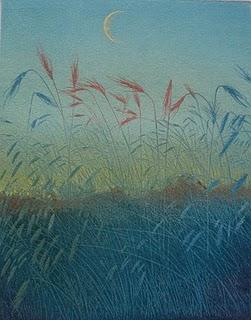 Arthur Illies, MondaufgangEtching, 1896
Arthur Illies, MondaufgangEtching, 1896The painter and printmaker Arthur Karl Wilhelm Illies was born in Hamburg in 1870, and died in Lüneberg in 1952. Illies studied at the Munich Academy of Fine Art, after which he returned to Hamburg, under the patronage of the director of the Hamburg Kunsthalle, Alfred Lichtwark. In the 1890s Illies worked in a Symbolist mode allied to Jugendstil. Arthur Illies was an innovative printmaker who, tired of the limitations of conventional colour etching, developed his own methods to bring a painterly richness of hue and tone to his etchings. He did this through multiple bitings of the etching plate in layers of aquatint, and also invented a method of printing colour etchings from a single plate by combining high and low pressure on the press.
I assumed from what I had read of Illies' printing methods, and from the subtle colour gradations of the etching itself, that Mondaufgang was printed "à la poupée", with the colours hand-applied to the plate and all printed at once, rather than one colour at a time. But I have since found the excellent site of the Arthur und Georgie Illies Familien-Stiftung (the Illies Foundation in Lüneburg), and it seems that in 1896 Illies was still using the more traditional au repérage method, with a separate plate for each colour. In the case of Mondaufgang, four plates were used. Illies printed the edition himself, an ambitious undertaking in the case of an etching for Pan, which had a print-run of 1300 ordinary copies on wove paper, plus some de luxe copies on Japan; the Illies website gives the total edition as 1600 copies. Alfred Lichtwark, who was on the editorial board of Pan, allowed Arthur Illies to set up a printing workshop in the former reading room of the Hamburger Kunsthalle. Even with assistants (probably eager young art students), it took Illies fourteen working days to print the edition, according to his diary. It was no doubt because of the complexity and ambition of his colouring that Illies preferred to print his own etchings on his own hand press.
On Mondaufgang the artist is credited as Artur Illies, but as reference books and the Illies website spell his forename Arthur, I assume that is the correct spelling. A mystery surrounds the title of the etching, which again is printed on every copy, as the Illies website gives it as Ährenfeld, Cornfield, rather than as Mondaufgang.
I will summarise here a few biographical details gleaned from the biography by Oliver Fok on the Illies website. From 1895-1908 Illies taught at the Women's Art School run by Valesca Röver. In 1908 he was appointed to run the life class at the Kunstgewerbeschule in Hamburg, where he was made Professor in 1926. In 1933 he retired to Lüneburg, where the city provided him with a studio in an old department store. In WWI Illies was a War Artist on the Eastern Front in Russia. As a Nazi supporter, he was able to continue exhibiting through the Nazi era and WWII. In 1945 he and his second wife Georgie were evicted from their home, and retreated to the department store studio. Illies married twice. In 1900 he married Minna Schwerdtfeger, who died the following year giving birth to their daughter Helga. In 1905 he married Georgie Rabeler, who had been his student at the Röver Malschule für Damen, with whom he had four children, Kurt, Herta, Harald, and Anke.
Oliver Fok estimates the total artistic output of Arthur Illies at 2,600 paintings, 1,200 drawings, and a large body of graphic work. Even in this extraordinarily productive life, the creation, printing, and publication of Mondaufgang, or Ährenfeld, must have been a highlight.

